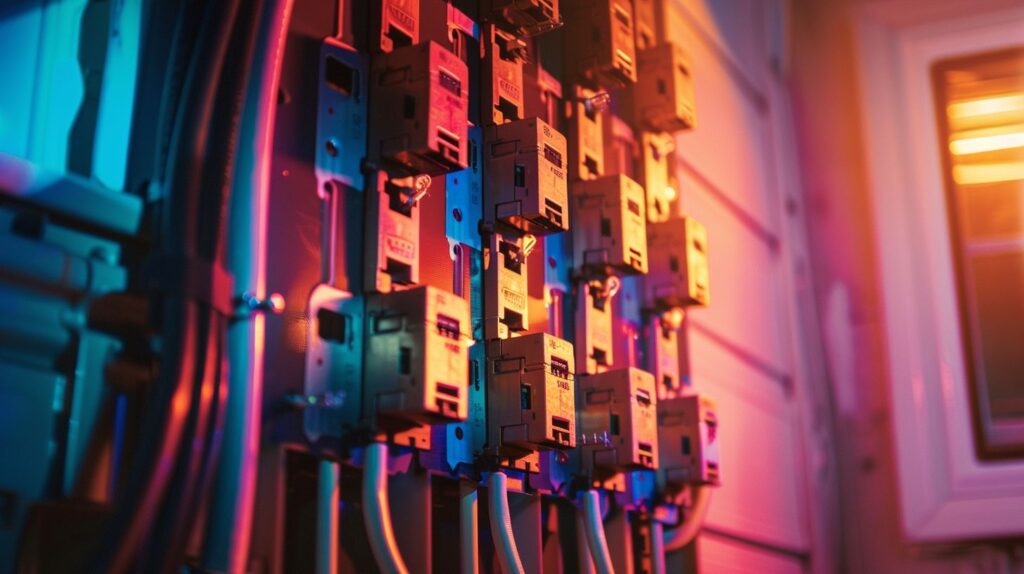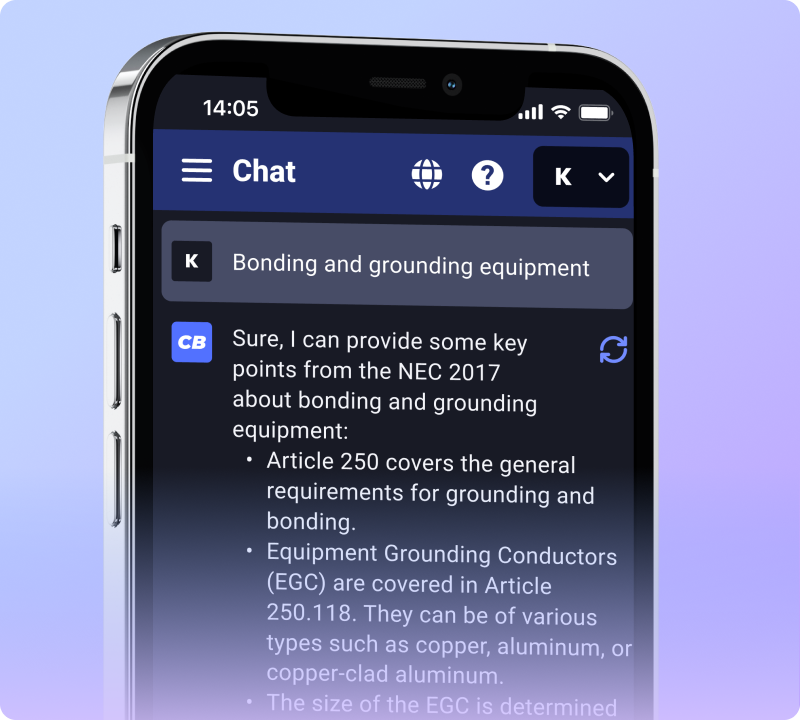Having trouble understanding why your home’s lights flicker or why appliances get damaged? A missing bond between ground and neutral at the main panel could be the culprit. This article will guide you through the importance of a bonding jumper for connecting these two critical parts of your home’s electrical system.
By ensuring they are properly linked, you can avoid many common electrical issues. Let’s get started on fixing that problem.
Key Takeaways
- Bonding neutral and ground at the main panel keeps your home safe. It stops electric shocks by giving fault current a safe path to the earth.
- The National Electrical Code (NEC) says bonding is a must. It helps prevent electrical fires and keeps voltage steady.
- Installing a bonding jumper correctly makes sure electricity works right. This means tight connections without damaging screws.
- Not bonding neutral and ground can cause dangerous situations. Floating neutral might hurt appliances, and missing bonds raise electrocution risks.
- Electricians use special tools like multimeters to check if bonding works well. This helps find problems early before they get worse.
Importance of Bonding Neutral and Ground
Bonding neutral and ground is crucial for safety enhancements and stability in system performance.
Safety Enhancements
Proper bonding between neutral and ground in the main panel ensures safety by preventing voltage from making grounded surfaces live. This crucial step reduces the risk of electric shock, safeguarding those nearby from potential harm.
By creating a safe path for fault current to travel, it activates the circuit breaker or fuse to interrupt the electrical supply. This action prevents dangerous situations like arc flash or fire.
Grounding systems also limit over-voltages due to lightning, surges, and faults thanks to grounding rods and grounding conductors. These elements work together with bonded neutral and ground connections to stabilize voltage levels throughout the building’s wiring.
Such coordination helps prevent power quality issues that can arise from ground loops circulating unwanted currents.
Safety isn’t expensive, it’s priceless.
System Performance Stability
Bonding neutral and ground in your breaker panel plays a key role in keeping the system stable. It helps prevent fault current from causing trouble. This means if there is a problem, like a short circuit, the bonding makes sure the breaker trips right away.
This stops the current and keeps everyone safe.
Good grounding also keeps power quality high by stopping noise sharing between circuits. But using too many ground rods can cause issues like ground loops which make power quality worse.
Simple steps like adding bonding jumpers keep electricity flowing smoothly and safely through your circuits, making your electrical setup stable and reliable.
Overview of Bonding in Electrical Panels
Bonding in electrical panels ensures the safety and stability of the system. It involves the neutral and ground connections to create a safe path for fault currents.
Definition of Neutral and Ground
The neutral wire acts as the return path for electricity to flow back after it powers devices. In a home’s 120V system, this white or gray wire ensures that electric current circuIates through appliances and lights before returning safely.
The ground wire, often bare copper or green, offers an extra layer of safety. It directs harmful electrical currents away from people and into the earth if something goes wrong, like a short circuit.
Grounding electrodes and system panels connect to these crucial wires to protect homes from electrical shocks and faults. Electricians link them at the main breaker box where they play key roles in preventing fire hazards and safeguarding against voltage spikes.
Neutral provides the pathway; ground ensures safety.
Now let’s explore how a bonding jumper bridges these two for better protection.
Purpose of a Bonding Jumper
A bonding jumper acts as a bridge between the grounding wire and the neutral wires in your main electrical panel. It plays a crucial role by making sure that, during an electrical fault, electricity has a safe path to follow back to the ground.
This action helps trigger the circuit breaker to shut off power, preventing shocks and fire hazards. Using mechanical parts like bonding screws, this connector secures a reliable bond that stops stray voltage, keeping everyone safe.
This essential component ensures that your home or building wiring follows national electric code (NEC) rules on earthing and grounding. Electricians use copper wires for this task because of their excellent conductivity.
Next up, let’s explore the specific code requirements around bonding jumpers according to NEC guidelines.
Code Requirements for Bonding
Meeting the NEC Guidelines is a must for bonding
Local codes may vary but must align with NEC standards.
National Electrical Code (NEC) Guidelines
The National Electrical Code (NEC), specifically in its 2008 edition, lays down strict rules for bonding neutral and ground in the main panel. This code aims to enhance electrical safety by preventing shock hazards.
It states that every main panel must have a connection between the grounded system and the earth ground. This is crucial for ensuring that in the event of a fault, harmful current can safely return to the ground without causing damage or injury.
NEC 250.24(B) goes a step further by requiring two neutral-ground bonds at each service disconnect enclosure. These bonds play a vital role in maintaining system performance stability and protecting against electrical fires and shocks.
The use of grounding electrodes recommended by NEC helps achieve this by providing high-resistance paths to dissipate unwanted currents safely into the earth.
Grounding and bonding are fundamental to electrical safety; they work together to ensure harmless dissipation of fault currents.
Local Code Variations
Moving from the guidelines set by the NEC, it’s key to note how local codes come into play. Cities and towns sometimes have unique requirements for bonding neutal and ground in electrical systems.
This is because each area might face different environmental conditions or follow varying safety protocols. For example, a coastal city may adopt stricter grounding rules to combat corrosion caused by salt air.
Utility companies often use the National Electrical Safety code (NESC) as a standard but adjust their specifications based on local needs. These modifications can influence whether neutral and ground wires connect at your service equipment or another location.
Knowing your local regulations is crucial for electricians since it ensures that installations comply with both national standards and regional necessities, ensuring optimal system performance and safety.
Installation Steps for Bonding Jumper
To install the bonding jumper:
– Locate the bonding jumper position
– Follow proper installation techniques
Identifying the Bonding Jumper Location
The bonding jumper lives in the main panel. Look for it there first. This piece is key to connect the grounding electrode conductor with both the neutral and ground bus bars inside your panelboard.
Use mechanical parts like bonding screws to make this connection strong. Also, ensure the main panel bonds well to the neutral to keep everything safe.
Before starting work, check if the factory has not isolated the neutral from other components. This step helps avoid issues with double insulation or faults that could happen if things aren’t set up right.
Always use proper connectors and follow National Electrical Code (NEC) guidelines while working on these connections. Keep an eye out for anything that seems off, such as a split phase without clear grounding paths or missing surge suppressors, which can show signs of trouble in your electrical system’s safety design.
Proper Installation Techniques
After finding where the bonding jumper fits, now we focus on connecting it right. Good bonding prevents electric shocks and keeps everyone safe. Here’s how to install a bonding jumper correctly:
- Use a bonding screw or jumper for a secure connection. This metal piece connects the ground bar to the neutral bar in the panel.
- Tighten all connections firmly but with care. Make sure not to over-tighten, as this can damage the terminal screws.
- Check your work by measuring voltage between a hot wire and a cover screw hole to verify proper installation.
- Always follow National Electrical Code (NEC) guidelines and local codes to ensure compliance and safety.
- Make sure all equipment, including fuses, switches, and circuit-breakers, has an interrupting rating suitable for the system’s voltage.
- Install double insulated tools and devices for extra protection against electrical faults.
- Provide ground fault protection by ensuring protective earth connections are in place for safety grounds.
- Securely fasten current-carrying conductors within conduits or enclosures to avoid loose wires that could lead to faults.
- Use concrete encased electrodes where required for grounding to enhance ground fault detection.
By keeping these steps in mind, electricians can ensure a safe and effective installation of bonding jumpers in main panels, contributing to overall electrical system safety and stability.
Common Questions About Bonding
Do ground and neutral need to be bonded at the meter? What happens if ground and neutral are not properly bonded?
Should Neutral and Ground Be Bonded at the Meter?
Bonding neutral and ground at the meter is not usually required. Main panels are often seen as sub-panels because they have a “service disconnect” switch. In devices that combine meters with main breakers, you find neutral-ground bonds.
Utilities might say bonding at the meter can is unnecessary.
Neutral and ground connections should mainly happen in the main panel, not at the meter.
What Happens if Neutral and Ground Are Not Bonded?
If neutral and ground are not bonded, it can lead to dangerous voltage in the grounding system and faults may not trip a breaker, posing an electrocution risk. Additionally, a floating neutral can cause damage to appliances.
Moreover, voltage doubling and high voltage can occur without bonding.
This lack of bonding poses serious safety risks as well as potential damage to electrical devices. Ensuring the proper bonding of neutral and ground is crucial for maintaining system stability and preventing hazardous situations.
Next: – Troubleshooting Bonding Issues
Troubleshooting Bonding Issues
If your electrical system has improper bonding, you may notice flickering lights and unexpected voltage fluctuations. A simple continuity test using a multimeter can help identify any bonding issues quickly.
Signs of Improper Bonding
Improper bonding can lead to voltage issues between the main and breaker box. Stray voltage in the grounding system may also indicate a lack of proper bonding. Additionally, floating metal boxes within an electrical setup could signify inadequate bonding, while loose connections in the panel are another sign of improper bonding.
Moving onto “How to Test for Effective Bonding”…
How to Test for Effective Bonding
To ensure effective bonding, follow these steps:
- Use a multimeter to measure voltage from a hot to a cover screw hole.
- Confirm zero voltage from the steel box to the ground/neutral bus.
- Check and tighten bonding screws or jumpers as needed.
- Utilize a bare metal surface for accurate voltage measurement.
These steps are crucial in testing and maintaining effective bonding within electrical panels.
Conclusion
Ensuring the proper bonding of neutral and ground at the main panel is crucial for safety and system stability. The National Electrical Code offers clear guidelines to safeguard against faults and over-voltages, underscoring the significance of this practice.
Electricians must adhere meticulously to code requirements when installing bonding jumpers to guarantee effective grounding. Faulty bonding can lead to severe electrical hazards, emphasizing the vital role of correct installation.
Stay informed about local variations in codes, as they may influence specific procedures for securing grounding rods effectively.





